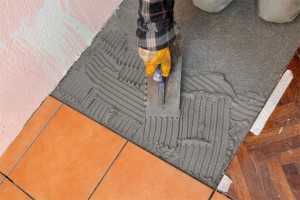As early as the 1930s, polymer binders were used to improve the performance of mortars. After the successful launch of polymer emulsions on the market, WACKER developed a spray drying process to provide emulsions in the form of rubber powder. The beginning of the era of dry-mix mortar.
For more than 100 years, ceramic tiles have been used as wall and floor coverings. Today they have become indispensable finishing materials. Tiles of various sizes, patterns and grades can be seen everywhere.
With the advancement of ceramic tile technology, the ceramic tile body is becoming denser and larger in size, which brings great challenges to the placement of ceramic tiles. How to make large-size tiles stick more firmly and ensure long-term paving reliability has become a new focus of attention in the field of modern decoration.
The bonding material (such as high molecular polymer) wets the surface of the ceramic tile and forms a state of wetting between the two, so that the molecular distance between the two is very small, and finally a huge intermolecular force is formed at the bonding interface to bond The material is closely integrated with the ceramic tiles. With the advancement of ceramic tile technology, more and more dense ceramic tiles are difficult to provide more gaps for mechanical interlocking to form anchors. But intermolecular force bonding is becoming more and more important.
The redispersible latex powder (RDP) forms a polymer network in the mortar product, which connects the tiles and the mortar through intermolecular forces. Even if the tiles are dense, they can be firmly attached to the mortar.
Redispersible latex powder is formed by the polymerization of two or more polymers, which have different hardness based on the different proportions of the polymer composition. When in a high temperature state, the rubber powder will show different degrees of softening due to its own hardness. The harder the rubber powder, the lower the softening degree at the same temperature, and the stronger the ability to resist external forces at high temperatures.
Therefore, for the rubber powder used in the tile glue, the rubber powder with high hardness is preferred, which can effectively ensure the long-term bonding in the high temperature environment.
When using the thin-layer construction method for tile paving construction, in order to facilitate the construction, workers will choose to apply a large area before tiling. In this process, the tile adhesive will form a crust on the exposed surface due to environmental wind speed, water absorption at the base layer, and dissolution and movement of cellulose ether within itself. Since wetting is the key to close bonding of materials, when the crust is difficult to be destroyed, it will be difficult for the tile glue to wet the tile surface, which will ultimately affect the bonding strength.
The choice of redispersible latex powder, on the one hand, due to its structure can play a certain role in water retention, delaying the rate of hydration and skinning. On the other hand, the adhesion per unit area can be improved, and the overall adhesion can be guaranteed even if the wetted area is reduced. At the same time, a reasonable choice of cellulose ether is also very important.
As the size of ceramic tiles increases, hollowing is more and more likely to occur after paving, and even accidents of tile falling off occur. This problem has a lot to do with the flexibility of the bonding material.
The ceramic tiles have high density and low deformation, and the base layer will have greater deformation due to various external and own factors. As the bonding layer, the tile glue must be able to absorb the stress caused by deformation. If the tile glue does not contain rubber powder, or the rubber powder content is low, it will be difficult to absorb the stress caused by deformation, causing the entire paving system to gradually fall off at the weak points and form a hollow drum.
Redispersible latex powder can provide tile adhesives with the ability to adapt to stress and deformation, that is, improve the flexibility of tile adhesives. In this system, the rigidity of the tile adhesive is mainly provided by inorganic materials such as cement and sand, and the flexibility is provided by the glue powder. The polymer intersperses in the pores of the cement stone to form a polymer network, which becomes an elastic bond between the rigid components, making it flexible. When deformation occurs, the polymer network can absorb the stress, ensuring that the rigid component will not crack and be damaged.
Therefore, improving the flexibility of the bonding material is very important to reduce hollowing. The proper amount of rubber powder can improve the state of the polymer in the tile adhesive to form a network structure.
Post time: Mar-04-2021





